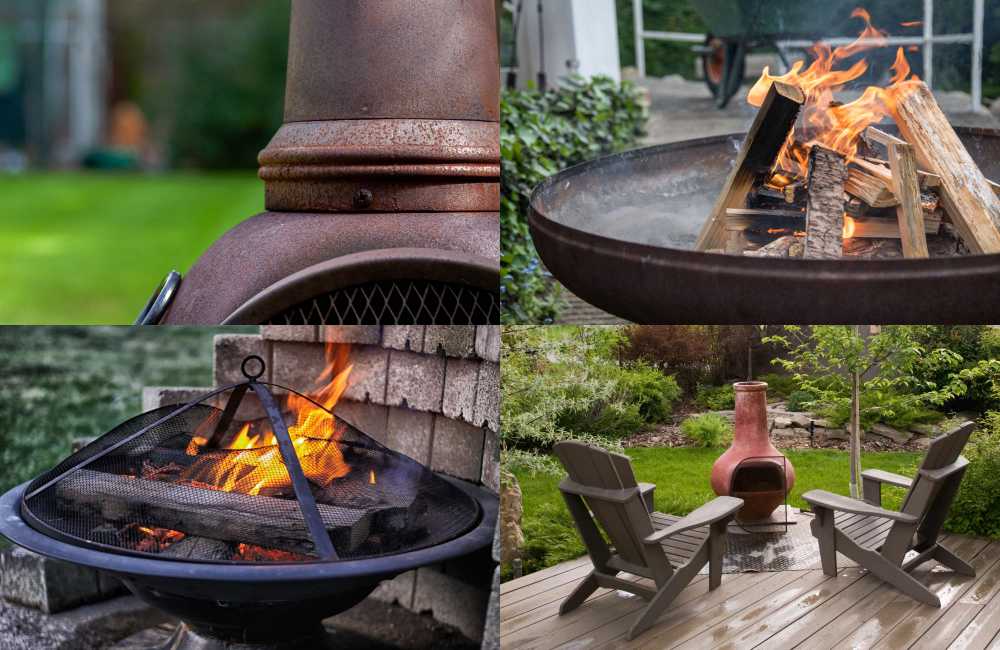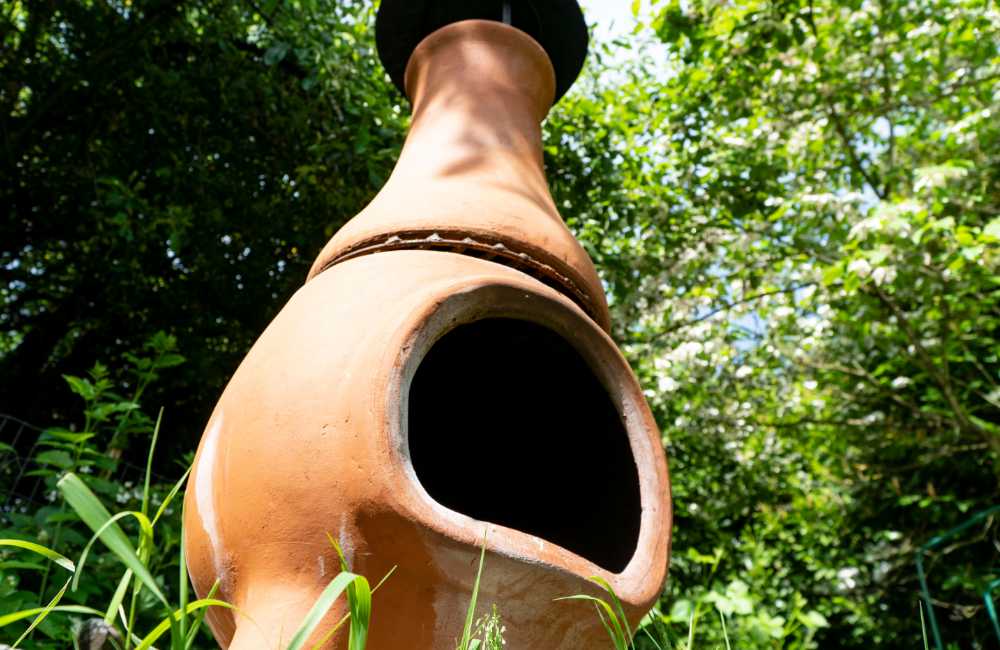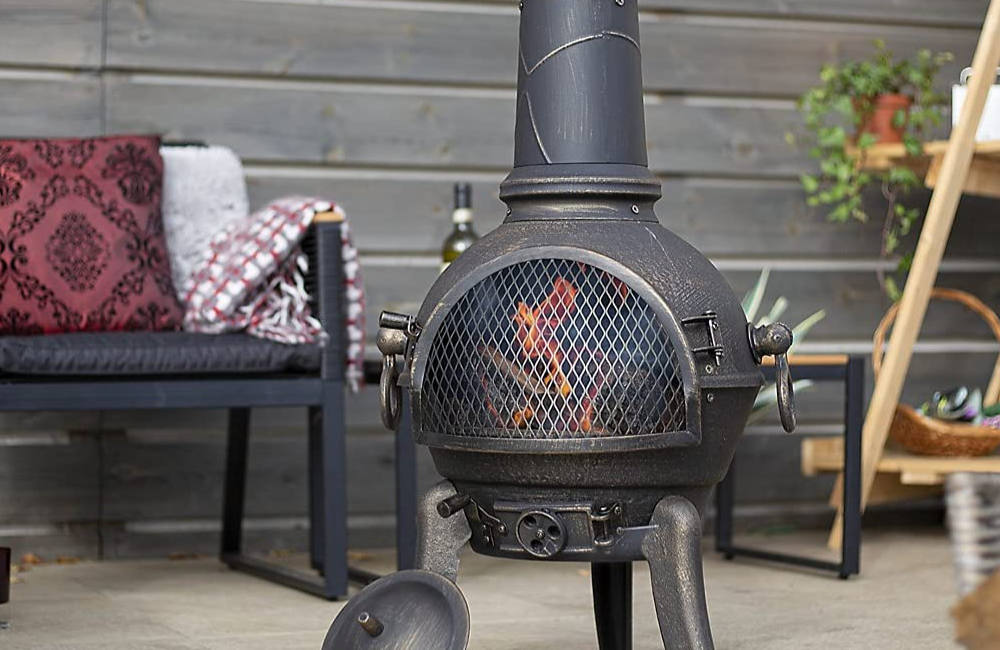Affiliate Disclosure: As an Amazon Associate, we earn from qualifying purchases.
Chiminea vs Fire Pit Which is Better?
If you’re thinking of buying something to keep you warm in the garden you may be wondering Chiminea vs Fire Pit which is better?.
Well, there really is no simple answer as both the chiminea and the fire pit have a place in your garden or on your patio. Whether you choose a chiminea or fire pit really will depend upon your needs and requirements. Chimineas are better for smaller areas whilst fire pits are more durable but whichever you choose, you first need to know what the difference is between the two. If you already know you want a chiminea then check out our chiminea shop.

What’s the main difference between a fire pit and a chiminea?
Before you can decide which is better you first need to know what’s the difference between a chiminea and a fire pit. Once you’ve discovered what the difference is you can then decide which one is best for your own personal circumstances.
The key difference between a fire pit and a chiminea is its shape. Fire pits are an open bowl without a chimney which allows you to burn larger pieces of wood and have larger fires with a 360 degree view. Chimineas originate from Mexico and have an enclosed fire bowl with a chiminea on top to take the smoke away and have a smaller opening to see the fire.
Chiminea vs Fire Pit What are the Differences?
Apart from their shape, there are a number of other differences between chimineas and fire pits. We’ve listed each below followed by an in-depth explanation of the differences.
- Smoke
- Appearance
- Ease of use
- Size of Space
- Fuel
- Safety
- Cleaning
- Durability
Smoke
Smoke can be annoying for both those around the heater and also neighbours. There are several differences between chimineas and fire pits when it comes to smoke. Burning the right fuel will limit the amount of smoke produced by either appliance. The dryer and more seasoned the wood, the less smoke it will provide.
The smoke produced by a chiminea is often less than that produced by a fire pit. This is because of two things. Firstly the chiminea has a chimney that directs any smoke up and away from your patio. Secondly, the bowl of the chiminea protects the fire from wind which promotes smoke. If you’d like to find out more about how to stop a chiminea from smoking take a look at our article.
Apperance
The great thing about chimineas and fire pits is that they both provide a beautiful focal point for any garden or patio. With a whole range of different designs available, it’s easy to find one to suit your tastes.
The main difference comes in the number of people you’re planning to have around your appliance. For smaller groups, there’s nothing better than a chiminea as the fire can be viewed through the small hole in its belly. Larger parties will be better around a fire pit as the fire can be viewed from 360 degrees.
Ease of Use
Both chimineas and fire pits are relatively easy to use. The main difference is in the preparation as with chimineas it’s best to place sand or gravel at the bottom before you light your fire whereas there is no such preparation with a fire pit as you can just add your kindling and logs and then light it up.
Size of Space
When it comes to the area where you’re going to put your appliance a chiminea is best for smaller areas whereas a fire pit is better for larger areas. A chiminea will look lost in a large garden and a fire pit will be too big for a small patio.
Fuel
The only difference in the fuel when it comes to a chiminea and fire pit is the size of the fuel. Fire pits, due to their openness allow you to use large pieces of firewood than chimineas. As the opening of a chiminea is much smaller, this will place a restriction on the size of wood that you will be able to use, meaning that you will have to cut your wood accordingly.
Safety
When it comes to safety both have their downsides, after all, they are both fires! A chiminea protects the fire from the wind and will therefore stop ash and embers from being blown around unlike a fire pit. Both a chiminea and fire pit are hot to touch and so there are safety concerns for children and animals.
A fire pit, when alight can be seen to be on fire from all around whereas with a chiminea you can sometimes only see it’s lit from the open side meaning the rear of the chiminea could be a hazard.
Cleaning
When it comes to cleaning, a fire pit is much easier to clean than a chiminea. With a fire pit, you have lots of space to scoop out the ash, unlike a chiminea where you will have to scoop the ash and embers out through the hole in its belly. Although this is not a massive issue for most it is a downside as you need to ensure it is cleaned after each use.
Durability
Both fire pits and chimineas will last a long time so long as you look after them and maintain them correctly. Traditional clay chimineas are more prone to damage due to the material they are made from but cast iron chimineas are more durable. Fire pits tend to be made from cast iron or steel and are therefore much more durable in the long term than chimineas.
What Are Chimineas and Fire Pits Made From?
Now we’ve covered the main differences between chimineas and fire pits we will look at what materials each is made from and the benefits of each.
Chiminea Materials
Chimineas can be made from clay and terracotta, steel, or cast iron. Below we will look at the difference between the three different types of material.
Clay and Terracotta Chimineas

Chimineas were traditionally made from both clay and terracotta when they were used in Mexico hundreds of years ago. They are often brightly decorated and come in a variety of styles to suit many tastes.
Chimineas are made in two parts, the chimney section and then the fire bowl section. Clay chimineas are more delicate than metal versions as they are prone to cracking under high temperatures and through being knocked, moved or dropped.
Although clay chimineas do get hot they do not get as hot as metal alternatives which makes them a little safer than cast iron and steel chimineas.
Cast Iron Chimineas

Cast iron chimineas are painted black and are great for providing high temperatures as they are not as prone to cracking as clay chimineas. The major benefit of the high heat is that they can heat a larger area and also maintain their heat long after the fire goes out.
Cast iron chimineas are also great for cooking on as the grease and oil from food will not damage the outer shell which is quite a common occurrence with clay chimineas.
The major downside to cast iron chimineas is that they stay hot, meaning they could be a safety concern and they are also prone to rust unless they are looked after properly.
Steel Chimineas

Steel chimineas are lighter than cast iron and clay chimineas and are also the most stylish. Their sleek steel shells lend themselves perfectly to some very modern lines and designs to improve any patio.
Although steel means these chimineas are easier to maintain and less prone to damage, they do tend to let themselves down on the heat front. They produce less heat and also retain less so are much more suited to smaller areas. Although steel chimineas are perfect for making a style statement, if you’re looking for the heat you may be better off with a cast iron or clay version.
Fire Pit Materials
Fire pits, like chimineas, can be made from a number of different materials from stone to cast iron. DIY and home-built fire pits tend to be made from concrete or stone whilst free-standing fire pits are usually made from steel or cast iron.
Stone and Concrete Fire Pits

If you’re planning on having your fire pit in a fixed position forever then you may decide to either build your own or have one built in your garden.
Home built and DIY fire pits are often made from concrete or stone and are built in a square or circular shape in your garden or patio.
The main advantage of these types of fire pit is that they generally require much less maintenance. The only problem with them is that they are fixed in position and unless you are a really good DIYer, you’ll either have to pay someone to build it for you, or you may end up with something that looks really bad.
The other major drawback with a stone or concrete fire pit is that they are fixed in position so if you want to move it about then you won’t be able to.
Cast Iron Fire Pits

Cast iron fire pits are great for really high-temperature fires. Similar to cast iron chimineas they can heat a larger area and also maintain their heat long after the fire goes out.
Although cast iron fire pits are heavier than steel models, they are still moveable, unlike concrete versions. Cast iron fire pits also need more care than concrete fire pits as they will rust if left out in the elements. Cast iron fire pits are however more durable than steel fire pits and will hold up to the elements for longer. Many people also prefer cast iron fire pits as they age slightly better than steel versions.
Steel Fire Pits

Steel fire pits are much lighter than cast iron fire pits meaning that they are much easier to move around your garden. This portability is the main benefit of steel fire pits as you are not required to stay in one place.
Steel comes in a variety of finishes including plain, painted, and powder-coated. The great thing about steel fire pits is that they come in some really great designs and styles that will suit any taste. If you’re worried about rust then make sure you go for stainless steel. These offer a great balance between steel and cast iron as they are corrosion resistant, and fairly easy to maintain.
Conclusion
Hopefully we’ve shown you that when it comes to chiminea vs fire pits that although there are differences both make a great addition to any garden or patio.
Whichever you decide to buy it will offer a useful and classy way to stay warm on those cold summer and winter evenings whilst providing a beautiful focal point for your guests.
